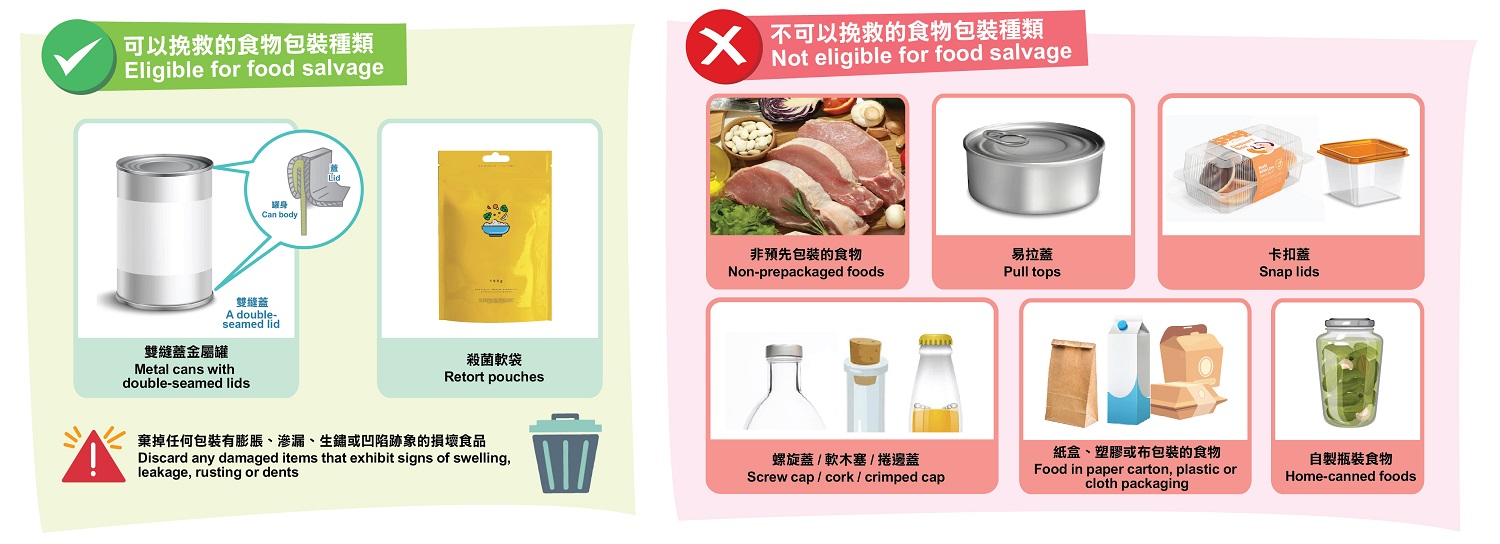
Food Safety Focus (193rd Issue, August 2022) – Article 2
Food Safety and Flooding
Reported by Mr. Arthur YAU, Scientific Officer,
Risk Communication Section, Centre for Food Safety
During the summer and typhoon seasons, Hong Kong often experiences severe and protracted rainstorms, where flooding may occur in some locations. With the advent of global climatic change, the combination of heavy rainfall, tropical cyclones and warmer temperatures is a recipe for more frequent flooding. Floodwater can contaminate food, and adverse weather might cause local or widespread power cuts, resulting in spoilage of perishable food due to disruption of refrigeration. While the sun shines, it is a good time to review how to prepare for such emergencies and deal with the fallout relating to food safety.
Food Safety Hazards of Floodwater
Flooding poses a potential food safety concern. Foods may be inundated in floodwater contaminated with sewage that can carry disease-causing microorganisms such as E. coli, Salmonella, hepatitis A virus and norovirus, as well as other contaminants. Dampened food is also susceptible to mould growth. Therefore, it is important to take proper precautions before and after a flood to ensure food safety.
If flooding is expected, position food storage areas and refrigerators as far away from floodwater as feasible. After floods, make sure all affected work surfaces, utensils and kitchen equipment are cleaned and disinfected before handling food. If wooden chopping boards and wooden utensils have come into contact with floodwater, dispose of them.
Food Salvage after Floods
When planning to salvage food after floods, it is important not to eat any food that has been submerged in floodwater and has not been packaged in a waterproof container. Only foods packed commercially in metal cans with double-seamed lids and retort pouches (i.e. shelf-stable food in packaging comprised of a flexible foil laminate. See Figure 2) are regarded as waterproof. After discarding any damaged items that exhibit signs of swelling, leakage, rusting or dents, the intact ones can be salvaged for consumption with careful handling: First, remove any labels and wipe or brush away any dirt or silt attached. Wash the packaging of the food items with water and soap and rinse thoroughly. This is followed by sanitisation, which can be achieved by immersing the items in clean boiling water for two minutes. Allow the sanitised items to air dry for at least one hour before storing, and relabel them with product information such as the product name and expiry date. These items should also be marked 'to be used first' and consumed as soon as possible.

Figure 2: Types of food packages that can and that cannot be saved after exposure to flood water
All non-prepackaged foods, as well as those not in a waterproof packaging, such as containers with screw caps, snap lids, pull tops or crimped caps that have come into contact with floodwater should be discarded. Food in paper carton, plastic or cloth packaging, as well as home-canned food, immersed in floodwater should also be tossed away. This is because there are no practical methods of reconditioning or processing to salvage these foods.
What to Do in Case of a Power Cut
Heavy rainstorms and flooding can occasionally disrupt power supplies, which render refrigerators and freezers incapable of keeping food at safe temperatures. Upon a power cut, take note of when it began. Keeping the refrigerator and freezer doors closed can help maintain a safe storage temperature. When electrical supply is restored, follow the ‘two-hour / four-hour principle’ for perishable items such as meat, seafood, eggs, dairy products and cooked dishes. When the power is off for more than four hours, do not taste the food to determine its safety. If in doubt, toss out the food.
Roles of Food Businesses
Food businesses have the responsibility of ensuring food safety, and should not supply discarded, spoiled or rotten foods damaged by floods or power cuts for human consumption. Defective food products should be set aside, bagged in refuse sacks and tagged as unfit for human consumption. Food businesses have to safely dispose of condemned food items to ensure that they will not be consumed. After emergencies, business should be suspended until thorough clean-up and disinfection is completed in order to prevent foodborne diseases caused by food contamination or poor environmental hygiene.


